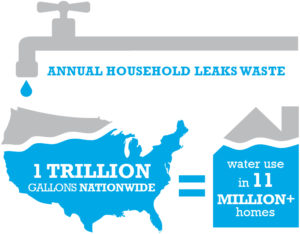Don’t Be a Drip, Stop Those Drops For “Fix a Leak Week!”
March 12, 2020Got leaks?
Then it’s a great time to break out the toolkit. This coming Monday kicks off the EPA’s annual Fix a Leak Week, which runs March 16 through March 22 this year.
“Fix a Leak Week is a great time to proactively do some checking to be sure leaks aren’t lurking where you don’t see or hear them,” says LCA Customer Care and Communications Manager Susan Sampson. “Our Customer Care team has free dye tablets available for customers to pick up and use to test for leaky toilets, a common problem that can go undetected. Please stop by one of our locations and get some. An average leaking toilet can waste up to 200 gallons of water per day!”
In fact, the EPA says that overall, leaks account for nearly 10,000 gallons of water wasted every year. “That’s the amount of water it takes to wash about 270 loads of laundry,” says LCA Customer Care and Communications Manager Susan Sampson.
What’s worse is that about ten percent of homes have leaks that waste 90 gallons or more per day! That’s a lot of  wasted water — and money!
wasted water — and money!
But even a little leak can add up to a big waste: A shower that leaks 10 drips a minute wastes more than 500 gallons a year. And a drippy faucet can send more than 3,000 gallons a year down the drain.
Simple Solutions
The good news is, it’s usually simple to fix leaks. Better yet, the fixes will pay for themselves in savings. Not sure if you’re losing water, or where a leak is coming from? Here are some helpful tips from the EPA:
- Take a look at your water usage during a colder month, such as January or February. If a family of four exceeds 12,000 gallons per month, there are serious leaks.
- Check your water meter before and after a two-hour period when no water is being used. If the meter changes at all, you probably have a leak.
- Identify toilet leaks by placing a drop of food coloring in the toilet tank. If any color shows up in the bowl after 10 minutes, you have a leak. (Be sure to flush immediately after the experiment to avoid staining the tank.)
- Examine faucet gaskets and pipe fittings for any water on the outside of the pipe to check for surface leaks.
One last point: Even if an older faucet, toilet or shower isn’t leaking, consider replacing it with an EPA-approved WaterSense product. You’ll start conserving water immediately, and will save money in the long run.
Ready to get started fixing leaks around the house? Click here for a handy, downloadable checklist. And for even more tips and tricks on finding — and repairing — water woes around the house, check out the EPA’s Fix A Leak Week website.